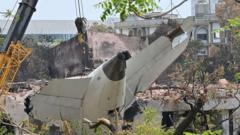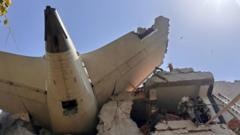A dramatic roof collapse at the historic Drum Tower in Fengyang County has led to an investigation amid concerns over the quality of recent renovations, triggering public scrutiny about the use of funds and safety measures.
Collapse of Historic Drum Tower Roof Sparks Safety Concerns in China

Collapse of Historic Drum Tower Roof Sparks Safety Concerns in China
The partial collapse of a renovated roof at the 14th-century Drum Tower in Fengyang raises questions about renovation standards.
The reconstructed roof of a historic tower in eastern China saw a partial collapse earlier this week, prompting an investigation into the quality of its recent renovations. The incident occurred at the Drum Tower located in Fengyang County, a notable cultural landmark dating back to the 14th century. Eyewitness reports captured moments of tiles sliding from the roof as a crowd gathered below, with no injuries reported according to officials.
The Fengyang government announced an inquiry into the incident, which has raised public concerns regarding whether modern renovations were conducted to satisfactory standards or perhaps even violated legal safety protocols. Video footage circulating on social media showed significant debris falling from the structure, causing onlookers to flee as a dust cloud enveloped the area.
Recognized as a key cultural relic by Anhui Province, the Drum Tower’s base is the largest among its peers in China and traces its origins to 1375 during the Ming dynasty. Historically, drum towers were integral to urban life, serving as timekeepers for communities. However, the current structure, with its decorative, tiled eaves, was rebuilt only in 1995 after the original was lost to destruction in the 19th century.
The recent renovation, carried out just last year to address specific issues of roof tile dislodgment, cost approximately 3 million yuan (around $420,000). Such spending has sparked discussions regarding potential financial misconduct and the efficacy of public investment in heritage sites. This is not the first time concerns have surfaced regarding the company managing the renovations, as a previous project involved an incidnet leading to fire damage and destruction.
As investigations continue, the incident serves as a stark reminder of the challenges in preserving historical sites in a rapidly modernizing world. Authorities and local stakeholders will need to ensure that such incidents do not recur in the future, promoting transparency and accountability in heritage conservation efforts.
The Fengyang government announced an inquiry into the incident, which has raised public concerns regarding whether modern renovations were conducted to satisfactory standards or perhaps even violated legal safety protocols. Video footage circulating on social media showed significant debris falling from the structure, causing onlookers to flee as a dust cloud enveloped the area.
Recognized as a key cultural relic by Anhui Province, the Drum Tower’s base is the largest among its peers in China and traces its origins to 1375 during the Ming dynasty. Historically, drum towers were integral to urban life, serving as timekeepers for communities. However, the current structure, with its decorative, tiled eaves, was rebuilt only in 1995 after the original was lost to destruction in the 19th century.
The recent renovation, carried out just last year to address specific issues of roof tile dislodgment, cost approximately 3 million yuan (around $420,000). Such spending has sparked discussions regarding potential financial misconduct and the efficacy of public investment in heritage sites. This is not the first time concerns have surfaced regarding the company managing the renovations, as a previous project involved an incidnet leading to fire damage and destruction.
As investigations continue, the incident serves as a stark reminder of the challenges in preserving historical sites in a rapidly modernizing world. Authorities and local stakeholders will need to ensure that such incidents do not recur in the future, promoting transparency and accountability in heritage conservation efforts.


















